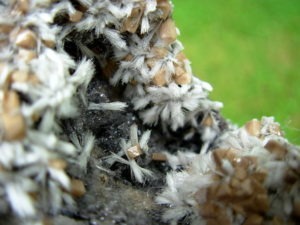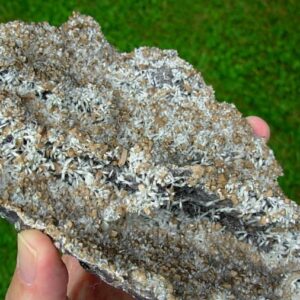Bultfonteinite and Poldervaartite

Poldervaartite is only found in the Kalahari Manganese fields in the N'Chwaning and Wessels Mines and is named after Arie Poldervaart of the Columbia University. It is an extremely rare mineral, found a few times in the Wessels mine, and again notably in N'Chwaning mine in a very large pocket. The first lot to come out in 2002 was all cream color. Around the middle of 2004, the last pocket was found, and this pocket only had small cream Poldervaartite crystals and white acicular Bultfonteinite crystals. Poldervaartite is associated with the minerals Henritermierite, Calcite, Bultfonteinite and Hematite.
Poldervaartite Ultraviolet Fluorescence is Deep Red under Short Wave (SW) UV Light.
To the west of Kuruman in the Northern Cape province, South Africa lies the massive manganese deposits of the Kalahari manganese field which covers at least 1100 square kilometres. These deposits have become world famous for the large reserves of ores and for the wide range of specimens identified and classified. There are 140 different species of minerals classified from this locale.
Olmiite is an interesting and rare mineral and was only described and named in 2006. Most crystals now called Olmiite were originally described as Poldervaartite. The name Olmiite has become accepted for the majority of the known material. Olmiite is named for Filippo Olmi, an Italian mineralogist.
The difference between Poldervaartite and Olmiite is not visually identifiable. Manganese dominates in Olmiite and Calcium dominates in Poldervaartite. Most of the earlier 1980's and 1990's finds at the Wessels Mine are Poldervaartite and the later finds from the N'Chwaning II Mine are Olmiite (Some of the 2004 pocket did test as Poldervaartite.) Both forms makes for some very unique and interesting specimens and they are always in high demand by collectors.

